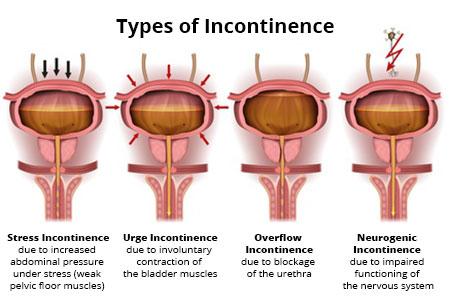ABOUT THE DISEASE
The loss of bladder control and unintentional passing of urine is called urinary incontinence (UI). It is a common problem and affects an estimated 17 million people worldwide. The problem is more common among women than men with women experiencing UI twice as often as men. Symptoms can range from minor leaks to uncontrollable wetting. Although it can happen to anyone, it increases with age.

SYMPTOMS
There are several types of urinary incontinence such as:
- • Stress incontinence - when urine leaks out at times when the bladder is under pressure, for example when during sneeze, cough or laugh
- • Urge incontinence - when urine leaks as one feels a sudden, intense urge to pass urine, or soon afterwards
- • Functional incontinence - When someone is physically or mentally impaired and cannot make it to the toilet in time. It can be due to impaired functioning of nervous system too.
- • Overflow incontinence - Experiencing frequent or constant leaking of urine because the bladder does not empty completely
Occurrence of more than one type of urinary incontinence is possible.
CAUSES
Stress incontinence is usually caused by the weakening or damaging of the muscles that prevent urination such as the urethral sphincter or pelvic floor muscles.
Urge incontinence is usually the result of overactivity of the detrusor muscles, which control the bladder.
Overflow incontinence is usually caused due to an obstruction to the bladder, which does not let it empty completely.
Other causes include:
• Obesity
• A family history of incontinence
• Pregnancy and vaginal birth
• Increasing age - although incontinence is not an inevitable part of ageing
• Constipation
• Menopause
• Hysterectomy
• Enlarged prostate
• Obstruction
• Neurological disorders
• Urinary tract infection
• Prostate cancer
DIAGNOSIS
- Urine testing
- Urodynamic testing
- Cystoscopy
- Cystogram
- Bladder diary - Record of the amount of liquid intake, when does the person urinate, the amount of urine produced, whether he or she had an urge to urinate and the number of incontinence episodes.
- Pelvic ultrasound
- EEG and EMG
TREATMENT METHODS
The type of incontinence, its severity and the underlying cause are the factors on which the treatment of urinary incontinence depends. Sometimes, a combination of treatments may also be needed. Doctor is likely to move from the least invasive treatments first and then on to other options in case the previous ones do not work.
1. Bladder training
2. Double voiding
3. Scheduled toilet trips
4. Management of fluid and diet
5. Exercises of pelvic floor muscle
6. Electrical Stimulation
7. Medications
8. Medical devices such as pessary.
9. Interventional therapies such as bulking material injections, Botox and nerve stimulators
10. Surgical procedures include sling operations, prolapse surgery, artificial urinary sphincter, bladder neck suspension
You may also like to learn about:
Bladder diseases
Bladder neurogenic
Bladder overactive
Stroke
Prostate enlargement
Neurologic diseases